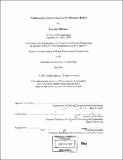| dc.contributor.advisor | Feniosky Peña Mora. | en_US |
| dc.contributor.author | Mizuno, Yusuke, 1975- | en_US |
| dc.contributor.other | Massachusetts Institute of Technology. Dept. of Civil and Environmental Engineering. | en_US |
| dc.date.accessioned | 2007-08-29T21:02:40Z | |
| dc.date.available | 2007-08-29T21:02:40Z | |
| dc.date.copyright | 2001 | en_US |
| dc.date.issued | 2001 | en_US |
| dc.identifier.uri | http://hdl.handle.net/1721.1/38860 | |
| dc.description | Thesis (M.Eng.)--Massachusetts Institute of Technology, Dept. of Civil and Environmental Engineering, 2001. | en_US |
| dc.description | Includes bibliographical references (leaves 93-94). | en_US |
| dc.description.abstract | In a large-scale disaster relief mission, a variety of personnel and organizations with different expertise take part in the relief activities towards a common goal. Interactions between them are important to promote efficiency, and the relief activities, especially search and rescue (SAR) activities, are carried out in a short time period. Some Emergency Offices of City/State/Federal governments and two case studies of actual disaster relief activities after large earthquakes were examined in order to recognize the issues in terms of collaborative environments during a disaster relief missions. These examinations have revealed the fact that the availabilities of site-specific information is a major concern when some decisions concerning relief activities are made, but the communication between on-site personnel and headquarters is not enough mainly due to the lack of cross-organizational coordination. Several commercial solutions have been developed and several studies have been made on collaborative environments at MIT. The current typical solutions consist of e-mail system, group discussion, bulletin board system, and shared data repositories integrated with mapping systems. Some further enhancements of these systems should be considered: multiple client access and detail design of thin portable client devices. To develop collaborative environments for disaster relief missions, the requirements have been gathered and the requirement analysis has been developed. According to functional role, relief mission participants are classified into four groups: field agent, team leader, coordinator, decision maker and specialist/advisor. The category "field agent" plays an integral role during a mission so that its activities are focused on. The hierarchy of collaborative session has been developed on account of that of participant roles. The multiple device access is an important functionality of collaborative environments. Some of the leading portable devices are featured and three types of wireless communication are described. To collect and report site-specific information in a disaster area is critical to make decisions. The needs and requirements of robot-human interaction that can be applied to a relief mission are discussed in comparison with SAR dogs. | en_US |
| dc.description.statementofresponsibility | by Yusuke Mizuno. | en_US |
| dc.format.extent | 94 leaves | en_US |
| dc.language.iso | eng | en_US |
| dc.publisher | Massachusetts Institute of Technology | en_US |
| dc.rights | M.I.T. theses are protected by copyright. They may be viewed from this source for any purpose, but reproduction or distribution in any format is prohibited without written permission. See provided URL for inquiries about permission. | en_US |
| dc.rights.uri | http://dspace.mit.edu/handle/1721.1/7582 | |
| dc.subject | Civil and Environmental Engineering. | en_US |
| dc.title | Collaborative environments for disaster relief | en_US |
| dc.type | Thesis | en_US |
| dc.description.degree | M.Eng. | en_US |
| dc.contributor.department | Massachusetts Institute of Technology. Department of Civil and Environmental Engineering | |
| dc.identifier.oclc | 49502961 | en_US |
